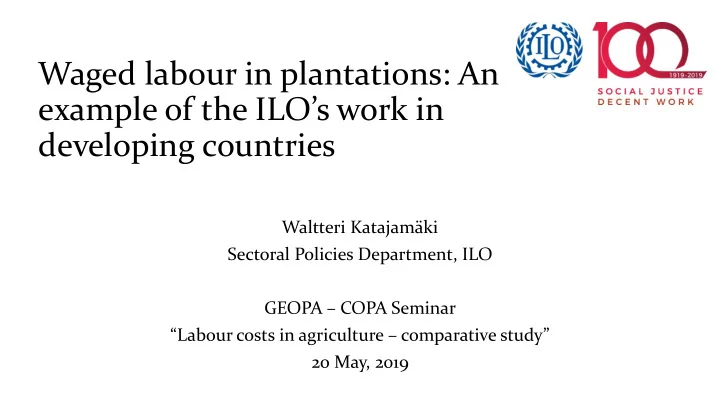

Waged labour in plantations: An example of the ILO’s work in developing countries Waltteri Katajamäki Sectoral Policies Department, ILO GEOPA – COPA Seminar “ Labour costs in agriculture – comparative study” 20 May, 2019
Employment in agriculture While the share of employment in agriculture has decreased… World Bank: Employment in agriculture (% of total employment) (modelled ILO estimate), https://data.worldbank.org/indicator/SL.AGR.EMPL.ZS
… still over 46%, of the world’s population, or 3.4 billion people, live in rural areas, where poverty rates are four times higher than in urban areas World Bank: Rural population, https://data.worldbank.org/indicator/SP.RUR.TOTL
“ The development of the rural economy, where the future of many of the world’s workers lies, should become a priority ” ILO Global Commission on the Future of Work, January 2019
Plantations diagnostics • Identify opportunities and challenges to promoting decent work in plantations • Based on tripartite dialogue : governments, workers, employers; plus small producers • Covers a range of issues from the fundamental principles and rights at work to technical topics dealt with in the Plantations Convention, 1958 (No. 110) • Outcome a national plan of action for improving working conditions • Diagnostics conducted in 5 countries and 3 crops , with several others under way
Employment • Challenging to recruit and retain workforce, high turnover • Contractual situation : • Both written and verbal contracts , with written contracts relatively uncommon, especially for casual workers • Workers generally aware of the terms and conditions of their employment • Common to consult workers in case contract terms change • Workers and employers may have differing views on the provision of contracts • Casual work common (particularly for women), depending on the crop • Use of external contractors to ensure sufficient labour force
Wages • Differences in wages: permanent workers generally receive above legal minimum wage , while casual workers’ monthly earnings may fall below • In some cases wages stipulated by collective bargaining • Wage often determined on a piece-rate basis (quotas), otherwise wages deducted • Particularly in case of casual workers wages determined and/or paid daily; while permanent workers paid monthly
Working conditions • Commonly 5 or 6 working days / week, 6-9 hours per day • Lunch break provided; access to clean drinking water and sanitary facilities • Annual leave entitlements differ between casual and temporary workers • In some cases employer provides accommodation to workers
Social protection • Most plantation workers covered by national contributory social security systems • Often access to health care, but may be of inadequate quality and/or not fully covered by insurance. Hospitals can be far away from the plantation • Maternity protection sometimes provided according to national legislation, but not for casual workers
Occupational safety and health • Various risks in plantations: heat, sun, animals, falling from trees, pesticides, back injuries and strain etc. • Uncertainty among workers about compensation and employer responsibility in case of accident • Even when provided by the employer, protective gear inadequately used • Inconclusive findings and differing views about frequency and quality of labour inspection • Training needed but rarely provided
Social dialogue • Collective Bargaining Agreements (CBAs) often in place in the formal plantation sector, determining wages and hours of work • Workers are generally knowledgeable about representative organizations, often free to join them, and in some cases union membership is high • Lack of understanding on the role of unions in negotiating working conditions • Casual workers may fall outside CBAs
Future of work in rural areas – ILO’s approach More productive and sustainable agricultural activities, capacity Stepping up building and decent work in agriculture Well connected and dynamic rural areas, attractive to investment Stepping ahead and to people for living and working in those areas Diversified activities throughout agricultural value chains and other Stepping out rural economic activities, reinforced rural-urban linkages between rural and urban areas
Recommend
More recommend